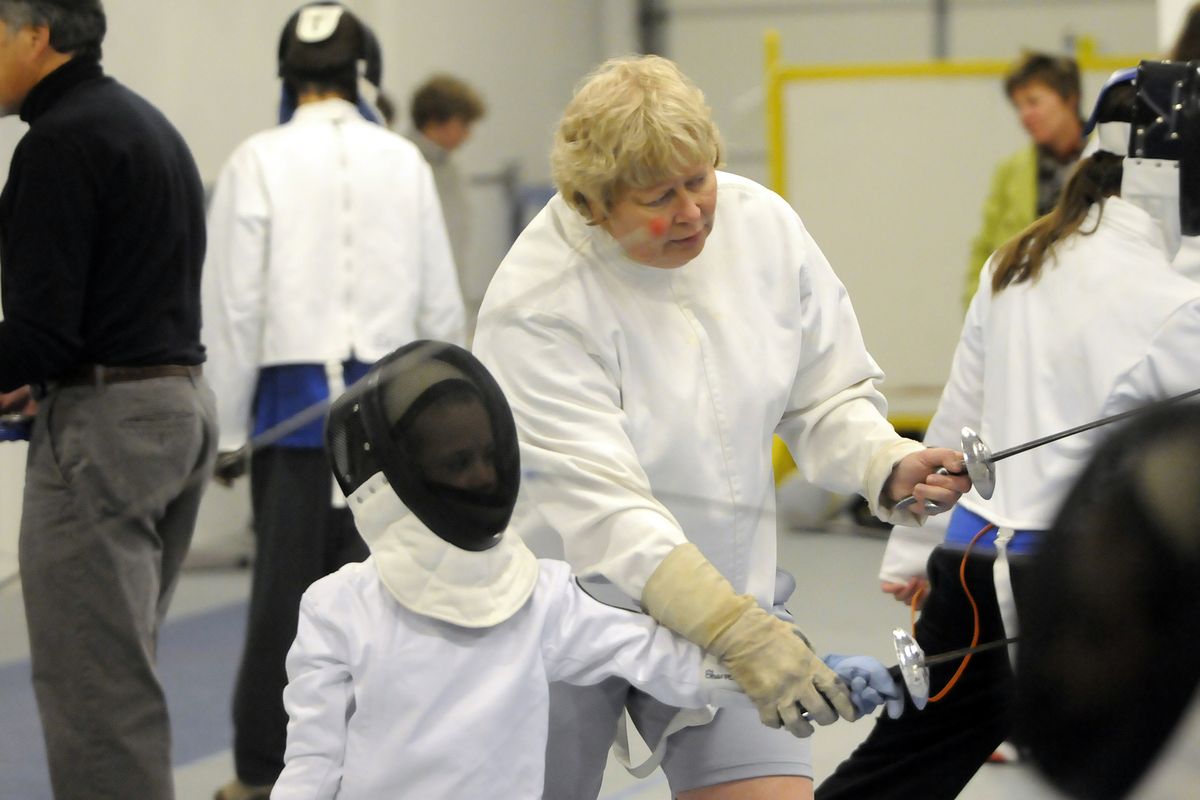Spokane fencing club draws young and old
In the ageless sport, finesse is a key part of skill

A visit to the Spokane Fencers Unlimited facility in north Spokane can feel like a trip back in time. A journey to an era of swashbuckling pirates before Johnny Depp, and Musketeers before the candy bar.
Since 1982, members of the fencing club have met weekly to parry, thrust and riposte. In addition, lessons for beginners are offered on Mondays and Wednesdays.
On a recent evening, the clang of steel on steel rang out, as two white-garbed, masked fencers faced off. “En garde,” said referee Paul Duchow. “Ready, fence!” And with that, Nate Balazs, 16, and Corrine Ankenbruck-Keogh, 18, lunged toward each other, swords extended.
But unlike duels of the past, success isn’t measured by drawing first blood. Instead, foils and epees (types of swords) are spring-tipped. Fencers are tethered to an electronic device, and when contact is made, a buzzer sounds and points are awarded by the referee.
Displaying footwork as fancy as any seen on television’s “Dancing With the Stars,” Balazs scored first. “Double touch,” said the referee. Ankenbruck-Keogh answered with a riposte, deftly blocking her opponent’s attack and scoring with a quick thrust of her own.
“They say 70 percent of fencing is footwork,” said club president Cole Carter as he observed them. “It’s all about putting yourself in a position to score and to defend yourself.”
For that reason, participants devote ample time to footwork each session, filling the room with the sound of shuffling feet as fencers advance, retreat and lunge.
Carter has been involved with the club for seven years. “My son wanted to pick it up when he was 12,” he said. “I went down and watched him for six months and then decided to try it.” Carter grinned. “He’s given up fencing, and I’m still doing it.”
It’s not difficult to understand the allure of this Olympic sport. Duchow, a 15-year-old Ferris sophomore, started fencing at 12. “You get to stab people with a sword,” he said. “How cool is that?”
Actually, Duchow would be the first to admit there’s a bit more to fencing than that. Fellow fencer Ken Lattin explained, “A lot of people think it’s swinging a blade at someone, but it’s a more finesse sport.”
Lattin, 52, picked up fencing in his 20s and still enjoys participating in tournaments. “I can be competitive with some of the younger guys because I have the head knowledge,” he said.
Indeed, fencing appeals to young and old alike. The members of Spokane Fencers Unlimited range from 8 to 83.
Seámus Welch, 8, is unabashed in his enthusiasm. “It’s just fun!” he said. “My grandpa and I used to do sword fighting with wooden swords that he made.” Welch paused for breath, his eyes big. “We’d fight without any form, and I just love it so much!”
When his grandmother discovered the fencing club, she asked him if he’d like to take lessons. He enthusiastically agreed. The activity has become a grandma/grandson date night.
“It’s our night out,” Welch confided. “We go out to dinner and have fast food!”
At the opposite end of the spectrum, 83-year-old Jack Warner, one of the club’s founding members, also enjoys the sport. “I like the interaction,” he said. “And I like that it’s a noncontact sport, ’cause I’m too old!”
The mingling among age groups makes this activity unique. Carter said, “Everyone here has an opportunity. There’s a lot of adult interaction, which is great for the kids.”
It’s also a coed sport. After narrowly losing a spirited match to Balazs, Ankenbruck-Keogh pulled off her mask. “The great thing about fencing is sex and size don’t matter,” she said.
She took fencing lessons from a friend’s dad in California. When it came to time to choose a college, Ankenbruck-Keogh said, “Fencing was one of my prerequisites.” While investigating Gonzaga University, she found Spokane Fencers Unlimited, and that sealed the deal for her college choice. “I like how it’s not a team sport and how it’s intellectual, yet physical.”
That combination has kept Maria Duthie, 49, engaged for many years. Duthie has competed at the national level and in 2001 won the Veteran (over-40) Women’s Epee Championship title.
“We don’t do the theatrical stuff,” she emphasized. “You don’t have to impale someone to score points. You get a card if you’re too brutal.” Similar to soccer referees, fencing officials issue yellow, red and black cards for various offenses.
In fact, Carter asserts that fencing is 10 times safer than volleyball regarding the number of injuries. Both Duthie and Carter said that in addition to safety, sportsmanship is a hallmark of fencing. “Respect for your opponent is incorporated,” Duthie said.
At the start of a match, opponents salute each other and the referee. When the match concludes, combatants are expected again to salute each other and shake hands. Failure to do so can result in a penalty.
Though etiquette is important, so is winning. Balazs relishes the challenge of the competition. “It’s like poker,” he said. By studying his opponents, Balazs can discover their “tell.” He also finds ways to rattle and annoy his competition. For example, he said, “You can use a feint, which is actually a fake. It’s presenting something that’s not there.” Such techniques can throw adversaries off their game.
According to Carter, Balazs is one of the best fencers in the club, and he is matter-of-fact about his skills. “My sister’s boyfriend wants to challenge me to a duel,” he said with a shrug. “But he knows I’d totally beat him.”
That blending of physical stamina and mental prowess is a challenging combination. “They say it’s like chess at 100 miles per hour,” said Carter.
Warner said contemporary fencing goes well beyond “hack and slash.” He said, “It’s more complex than people realize. It’s a head game that keeps your brain and body working.”